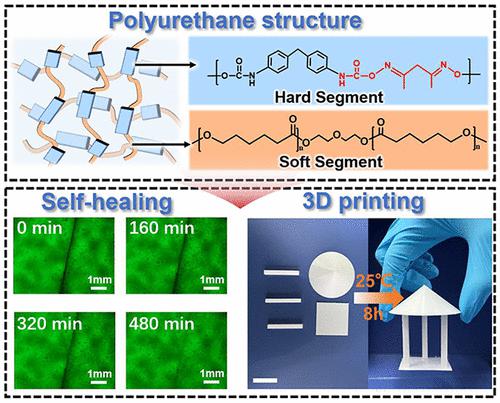当前位置:
X-MOL 学术
›
ACS Appl. Polym. Mater.
›
论文详情
Our official English website, www.x-mol.net, welcomes your feedback! (Note: you will need to create a separate account there.)
Oxime-Urethane-Based Self-Healing Polyurethane for Achieving Complex Structures via 3D Printing
ACS Applied Polymer Materials ( IF 5 ) Pub Date : 2024-03-22 , DOI: 10.1021/acsapm.4c00140 Fenglong Li 1, 2 , Xiaolin Wang 1 , Jiyang Zuo 3 , Chao Chen 1, 2 , Jing Chen 1 , Jin Zhu 1 , Wu Bin Ying 4
ACS Applied Polymer Materials ( IF 5 ) Pub Date : 2024-03-22 , DOI: 10.1021/acsapm.4c00140 Fenglong Li 1, 2 , Xiaolin Wang 1 , Jiyang Zuo 3 , Chao Chen 1, 2 , Jing Chen 1 , Jin Zhu 1 , Wu Bin Ying 4
Affiliation

|
3D printing has emerged as a highly accurate, highly customizable, and low-cost fabrication method to realize structures with designed geometry. However, the integral printing of complex structures, such as suspended structures, still poses significant challenges in the most commonly used 3D printing technology-fused filament fabrication (FFF). Therefore, designing a self-healing material, segmenting the printing of complex structures, and finally assembling them into a whole by the self-healing capability are expected to resolve this issue. In this research, we successfully synthesized a self-healing polyurethane (LNPU-3) with the introduction of dynamic oxime-urethane bonds. Specifically, we employed polycaprolactone diol as the soft segment, 2,4-pentanedione dioxime as the chain extender, and 4,4′-methylenebis(phenyl isocyanate) as the hard segment. LNPU-3 exhibited outstanding mechanical properties, with a tensile stress of 8.5 MPa and a fracture toughness of 20.1 MJ/m3. Even after cyclic stretching five times at a strain of 30%, the specimen could still recover 95% of its original value. Furthermore, LNPU-3 could be fully self-healed at room temperature (25 °C) within 8 h, with a healing efficiency of 92.9%. Finally, LNPU-3 was successfully printed by using FFF and the self-healing capability of the printed samples was tested. The printing components were then assembled into a complex structure that was difficult to print as a whole. In summary, LNPU-3 is an ideal self-healing 3D printing material, demonstrating significant potential for the application of self-healing materials and the advancement of 3D printing technology.
中文翻译:

基于肟-聚氨酯的自修复聚氨酯可通过 3D 打印实现复杂结构
3D 打印已成为一种高精度、高度可定制且低成本的制造方法,可实现具有设计几何形状的结构。然而,复杂结构(例如悬浮结构)的整体打印仍然对最常用的3D打印技术——熔丝制造(FFF)提出了重大挑战。因此,设计一种自修复材料,分段打印复杂结构,最后利用自修复能力将其组装成一个整体,有望解决这一问题。在这项研究中,我们通过引入动态肟-氨基甲酸酯键成功合成了自修复聚氨酯(LNPU-3)。具体来说,我们采用聚己内酯二醇作为软链段,2,4-戊二酮二肟作为扩链剂,4,4'-亚甲基双(异氰酸苯酯)作为硬链段。 LNPU-3表现出优异的机械性能,拉伸应力为8.5 MPa,断裂韧性为20.1 MJ/m 3。即使在30%应变下循环拉伸5次后,样品仍能恢复到原始值的95%。此外,LNPU-3可以在室温(25℃)下8小时内完全自愈,愈合效率为92.9%。最后,利用FFF成功打印了LNPU-3,并测试了打印样品的自修复能力。然后将打印组件组装成复杂的结构,很难整体打印。综上所述,LNPU-3是一种理想的自修复3D打印材料,为自修复材料的应用和3D打印技术的进步展现了巨大的潜力。
更新日期:2024-03-22
中文翻译:

基于肟-聚氨酯的自修复聚氨酯可通过 3D 打印实现复杂结构
3D 打印已成为一种高精度、高度可定制且低成本的制造方法,可实现具有设计几何形状的结构。然而,复杂结构(例如悬浮结构)的整体打印仍然对最常用的3D打印技术——熔丝制造(FFF)提出了重大挑战。因此,设计一种自修复材料,分段打印复杂结构,最后利用自修复能力将其组装成一个整体,有望解决这一问题。在这项研究中,我们通过引入动态肟-氨基甲酸酯键成功合成了自修复聚氨酯(LNPU-3)。具体来说,我们采用聚己内酯二醇作为软链段,2,4-戊二酮二肟作为扩链剂,4,4'-亚甲基双(异氰酸苯酯)作为硬链段。 LNPU-3表现出优异的机械性能,拉伸应力为8.5 MPa,断裂韧性为20.1 MJ/m 3。即使在30%应变下循环拉伸5次后,样品仍能恢复到原始值的95%。此外,LNPU-3可以在室温(25℃)下8小时内完全自愈,愈合效率为92.9%。最后,利用FFF成功打印了LNPU-3,并测试了打印样品的自修复能力。然后将打印组件组装成复杂的结构,很难整体打印。综上所述,LNPU-3是一种理想的自修复3D打印材料,为自修复材料的应用和3D打印技术的进步展现了巨大的潜力。



























 京公网安备 11010802027423号
京公网安备 11010802027423号